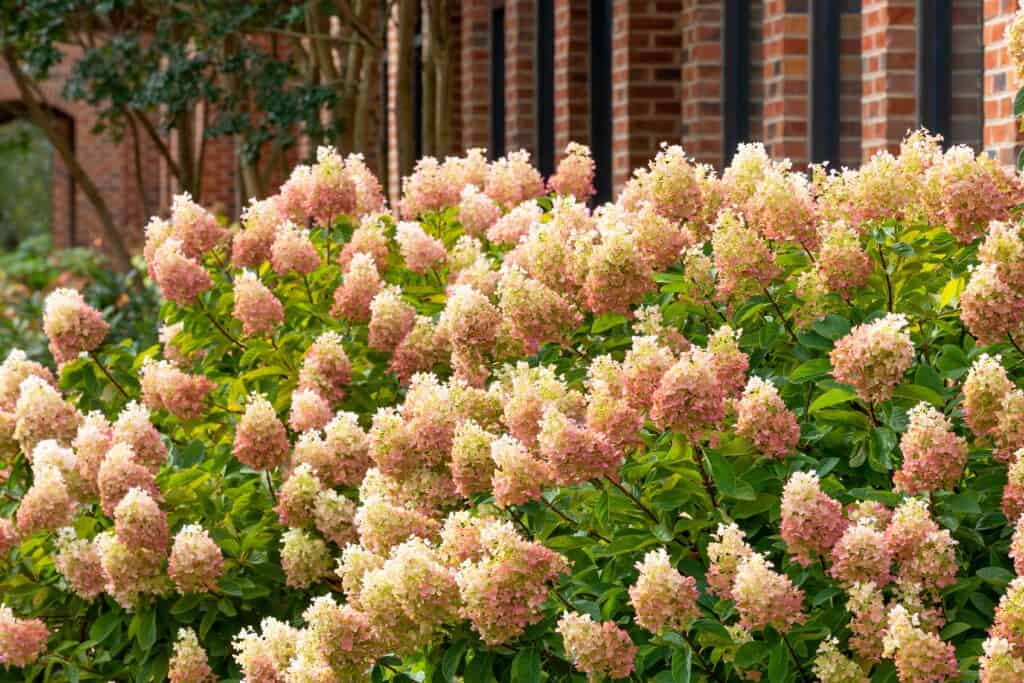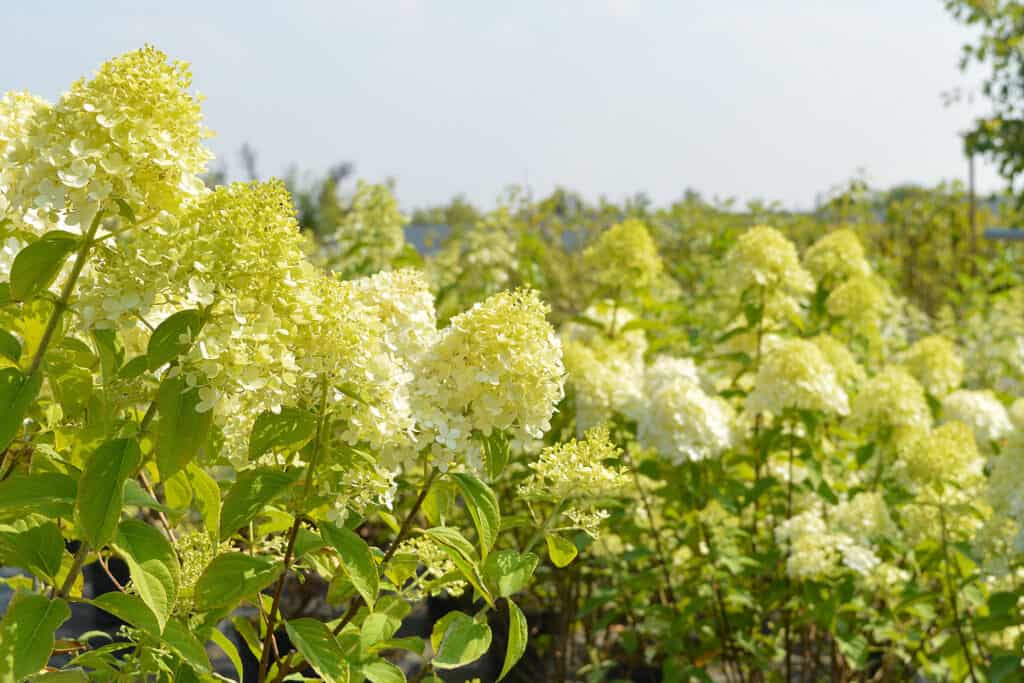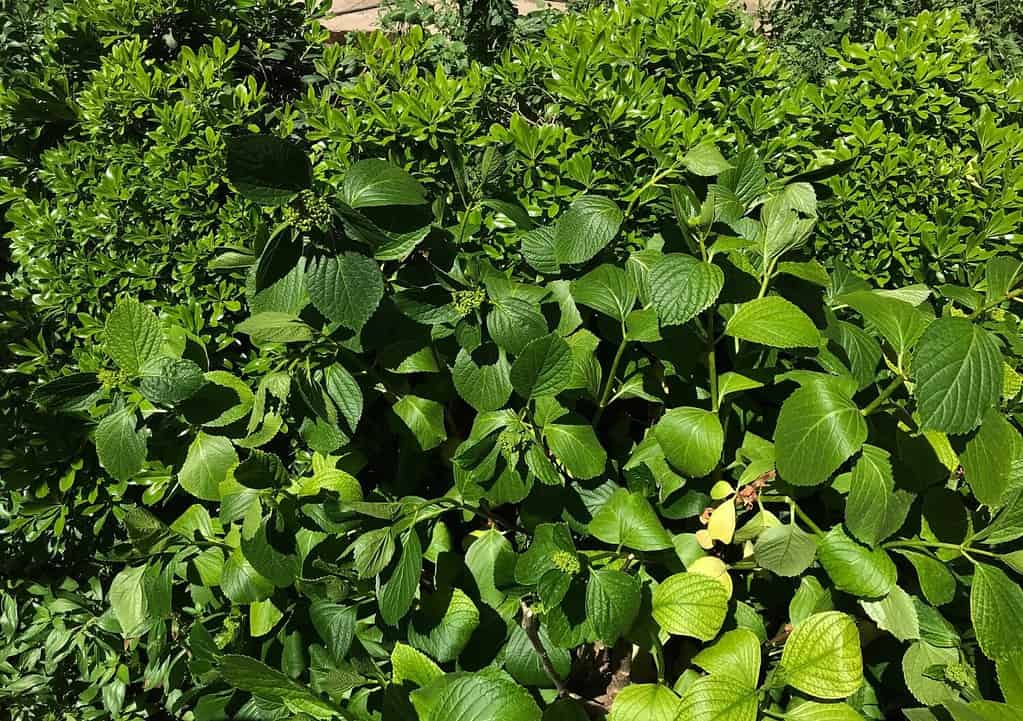Hydrangea, also known as hortensia, is one of 75 flowering plants native to Asia. Recognizable by their bulky bush shape and large, impressive clusters of brightly colored flowers, hydrangeas are fast-growing, hardy shrubs that spread rapidly. Most limelight hydrangeas are deciduous shrubs, but one variety, the Limelight hydrangea, can take the form of a small tree if given regular pruning and shaping.
How does the Limelight hydrangea bush morph into a tree? In this article, we will define what a hydrangea is, discuss the reasons why Limelight hydrangeas are different from other shrubs in the same family, and learn how a Limelight hydrangea bush might become a tree.
| Limelight Hydrangea Tree | Limelight Hydrangea Bush | |
|---|---|---|
| Plant Classification | Hydrangea paniculata ‘Limelight’ | Hydrangea paniculata ‘Limelight’ |
| Description | The Limelight hydrangea tree is a short hardy perennial with large, showy clusters of tiny mixed-colored flowers. A single-stem trunk holds the deciduous foliage of large dark green leaves aloft. Branches are plentiful and robust. Flowers start pale green and develop deep hues according to the pH of the soil. | The Limelight hydrangea bush is a short hardy perennial that flowers from early spring into late autumn. The popular garden bush has strong branches which sprout from the base of the plant with deep green leaves and hold large clusters of multicolored flowers. |
| Origin | The Limelight Hydrangea tree hails from Asia, specifically from regions in China and Japan. | Hydrangea paniculata originates from China and Japan. |
| Uses | As hydrangea bushes are more commonly seen than trees, Hydrangea paniculata forms a beautiful and unusual plant. Its hardy nature and prolific growth rate mean it thrives in most zones in the US and across Europe and Asia. The unique flowers are often dried for floral arrangements. | As the hydrangea bush is fast growing and its showy, colorful flowers are a delightful addition to any garden, the plant is grown in most zones of the US and grows in the wild in Europe. |
| Facts | Flower heads of the Limelight hydrangea can grow up to 12 inches long. | The Limelight hydrangea can grow from 6-8 feet tall and 6-8 feet wide. |
Limelight Hydrangea Tree vs. Limelight Hydrangea Bush Description
Limelight hydrangea is a cultivar with spectacular and colorful blooms. Both shrub and tree have dark green leaves on bended solid branches that tend to rise from the bush’s base. Shrubs may grow from 3 feet to over 8 feet tall. Large clusters of flowers appear in spring, forming flowerheads known as panicles which bloom until late autumn, often changing color dramatically during the season.
The limelight hydrangea tree is similar to the bush in size, flowers, and leaves. The main difference is in pruning methods. The base branches of the limelight hydrangea need regular pruning to form a strong trunk holding the unusual crown on top. Stems are strong enough to hold the large flowerhead clusters aloft without drooping.
Bush Classification

Stunning bi-colored limelight Prime Hydrangea shrub in full bloom.
©Dee Browning/Shutterstock.com
Both the Limelight hydrangea bush and tree are classified as Hydrangea paniculate. Limelight belongs to the Macrophylla family, characterized by large leaves which can grow up to 6 inches in length.
Bush Flowers
Limelight hydrangea has vast, showy flowerheads known as corymb. Two distinct flowers nestle together and resemble an umbel. The central, non-ornamental flowers are small and full of pollen and nectar. Sterile flowers surround the central stamens and aid in attracting pollinators.
The Limelight often occupies the center of attention in show gardens! Flowers range from pale cream, light green, pastel pink, baby blue, ruby red, or deep purple. It is common to see many colors appearing on one bush simultaneously.
Bush Origin
‘Hydrangea’ derives from the Greek words ‘hydros,’ meaning water, and ‘angos,’ meaning jar. Together, they form a ‘water vessel.’ Many believe this came about due to the shape of its seedpods.
45–65-million-year-old fossil records indicate hydrangea may be native to the Americas. It was not until the 18th century that hydrangeas made their way to Europe and took their place in gardens and allotments across the continent.
Limelight hydrangea is a cultivar with no native origin. Renowned horticulturist Pieter Zwijnenburg created the Limelight hydrangea in the 1980s. The name Limelight stems from its incredible showy flowerheads. Paniculata refers to the nature of the hydrangea flowers arranged in panicles along a central axis.
Limelight Hydrangea Tree vs. Limelight Hydrangea Bush Pollinators
The hydrangea is a food source for many insects, birds, and mammals. Insects that sup the plant’s nectar include bees, wasps, beetles, caterpillars, and aphids. Birds may also feed off hydrangea flowers, but they mostly scour the flowering plant for insects. Your hydrangea plant may also attract various so-called pests, from snails and slugs to squirrels and rats.
Limelight Hydrangea Tree vs. Limelight Hydrangea Bush Special Features
Hydrangea flowers undergo an impressive change in color from pale green to bright blue, pink, and red as the year progresses. The flowers finish the flowering season in late autumn with pretty pale cream petals. Did you know hydrangea can also change color based on the pH of the soil in which it grows?
By simply looking at Hydrangea’s flowers, we can tell a lot about the pH of the soil and what needs adjusting. Base, unsaturated acidic soil with a pH lower than seven will produce hydrangea flowers of royal blue or deep purple color. In contrast, alkaline soil with a pH of 7 or above results in bright pink or red flowers.
Gardeners frequently add minerals to the ground to achieve their preferred petal colour. Chemical fertilizers mixed specifically for hydrangeas may be applied to the soil once a year in early spring. Avoid fertilizing Hydrangea past summer, as this may be detrimental to its well-being.
Floral color changes in plants also occur due to a process called hyperaccumulation.
Limelight Hydrangea: What is Hyperaccumulation?
Like other plants in the genus, limelight hydrangea trees and shrubs are hyperaccumulators. Hyperaccumulating refers to the plant’s ability to absorb vast amounts of heavy metals found in the soil. These plants can absorb hundreds or even thousands of times the concentration of heavy metals, which would be toxic to other species.
Recent studies indicate that hyperaccumulating plants may be helpful for soil clean-up and pollution control in the future. Other plants and trees that hyper-accumulate heavy metals include various types of grass, rapeseed, many kinds of ferns, hyacinth, sunflower, and clover.
Scientists are still determining what causes a plant to hyper-accumulate. Still, most evidence thus far points to elemental defence. Hyperaccumulating is a coping mechanism to deter predators by making its foliage unpalatable or toxic.
Limelight Hydrangea Tree vs. Limelight Hydrangea Bush Cultivation

Limelight hydrangea growing in a field.
©Mari_Piman/Shutterstock.com
Limelight hydrangea trees and bushes are easy garden plants with few requirements. They thrive in either full sun or partial shade; they are frost-resistant and weather resilient. Plant in early spring or early fall as the season’s moderate temperature and conditions will aid the plant in establishing its roots.
Providing well-drained sandy or loamy soil for your Limelight hydrangea will ensure the best results. If the plot becomes waterlogged, the plants will suffer. Symptoms of waterlogged plants include yellowing foliage, leaf loss, and stunted growth. Hydrangea requires moisture in warmer temperatures. You can apply organic mulch at the base to prevent soil from drying. Once established, Limelight hydrangea is a hardy, fast-growing, drought-tolerant addition to any garden.
Limelight hydrangea trees may be grown in containers. Still, they will require much pruning to gain the desired shape. Therefore, a dwarf variety of hydrangea may be more suitable for your circumstances. Consider planting a Little Lime hydrangea instead.
Bush Facts
- Most hydrangea shrub varieties cannot form the typical single trunk and foliage crown style that limelight hydrangea can. Regular pruning and shaping are necessary to create and retain the crown-shaped tree.
- Hydrangea are toxic to pets and humans due to the hyperaccumulation of heavy metals in the leaves. Only the Hydrangea serrata can make a non-toxic herbal tea. Various insects, birds, and mammals supplement their diets with hydrangea nectar.
- Dried flower arrangements often include Hydrangea flowerheads. When cut, they retain their round shape and bright color.
- Flower clusters appear on the Limelight’s new growth. Pruning should occur in early spring. Remove any dead or damaged branches and eliminate any that cross over each other or distort the plant’s natural shape. Hydrangea can survive even extreme pruning; regular cutbacks produce a stronger shrub.
- Many varieties of hydrangea found in the wild may have few to no flower clusters. Colorful flowers emerged from breeding the hydrangea family.
- Hydrangea flowers are just one part of the plant that can change color. Hydrangea leaves that appear dark green in spring may take on a red tinge by September.
- Limelight hydrangeas need pruning to create a hedge or windbreak, but beware, each plant will expand to up to 8 feet wide, so plan accordingly.
- Hydrangea is invasive in many countries and habitats, particularly the islands of the Azores and Madeira. The Azorean Island of Faial is called the Blue Island due to the quantity of blue hydrangea present. They thrive in acidic, high-aluminum soil.
Limelight Hydrangea Tree vs. Limelight Hydrangea Bush Overview
Limelight Hydrangea trees and bushes are the same species and share many characteristics. The only difference lies in pruning methods to create the single-stemmed trunk and round crown-shaped foliage on top. Limelight hydrangeas are hugely popular in gardens due to their showy flowers. Still, they are also a low-maintenance solution to provide privacy or a windbreak.
When you spot a Limelight hydrangea, you’ll understand the constant, green-fingered pruning required to turn this deciduous shrub into an unusual and decorative little tree!
Bonus: Hydrangeas Not Blooming? We Have the Answers

It can be disheartening to realize that your hydrangea isn’t going to bloom.
©Hatice Sever/Shutterstock.com
If you look forward to seeing your hydrangeas bloom every year – it is a great disappointment when those big showy blooms never come. The leaves are lush and green but either buds never form or don’t develop – what has gone wrong? There are many things that can keep your hydrangeas from blooming – here are some reasons and solutions:
- Too Much Shade. Depending on the variety – most hydrangeas can tolerate a little shade – but most need several hours of direct morning sun. Consider moving your plant to a better location.
- Too Much Sun. Apparently, a sweet spot must be found for these plants. Too much direct sun may stress the plants causing them to conserve energy by not flowering.
- Improper Pruning. It is crucial for you to learn whether your hydrangea variety blooms from old wood or new – and prune accordingly. Bigleaf, oakleaf, climbing, and mountain varieties all bloom on old wood. Unless they get too big – it’s best not to prune them at all. The blooms will dry out and be replaced with new flowers next season. Panacle and smooth varieties bloom on the current season’s growth. (Limelight and White Wedding) Prune these in late winter or early spring.
- Cold Weather. A harsh winter or hard freeze can damage developing flower buds, which may result in a summer with no flowers. Mulch the area around the base of the plants in fall with several inches of leaves or straw to insulate roots. Protect plants with a covering during cold spells or frosts.
- Not enough water. Hydrangeas need a lot of water to do well. Too little water can result in stunted growth or no blossoms the next season. If plants are drooping or wilting they need to be watered immediately.
- They are too young to bloom. It can take newly planted hydrangeas up to 5 years before they begin blooming. You can buy larger plants if you want flowers sooner.
The photo featured at the top of this post is © iStock.com/Valentyna Tymchenko
Sources
- Wikipedia, Available here: https://en.wikipedia.org/wiki/Hyperaccumulator
- World of Garden Plants, Available here: https://worldofgardenplants.com/hydrangea-tree-vs-bush/
- Plant Addicts, Available here: https://plantaddicts.com/limelight-hydrangea/
- This Old House, Available here: https://www.thisoldhouse.com/gardening/reviews/limelight-hydrangea-trees/
- Future Forests, Available here: https://futureforests.ie/products/hydrangea-pan-limelight
- Gardeners World, Available here: https://www.gardenersworld.com/plants/hydrangea-paniculata-limelight/
Thank you for reading! Have some feedback for us? Contact the AZ Animals editorial team.






